Page 1306 of 2896
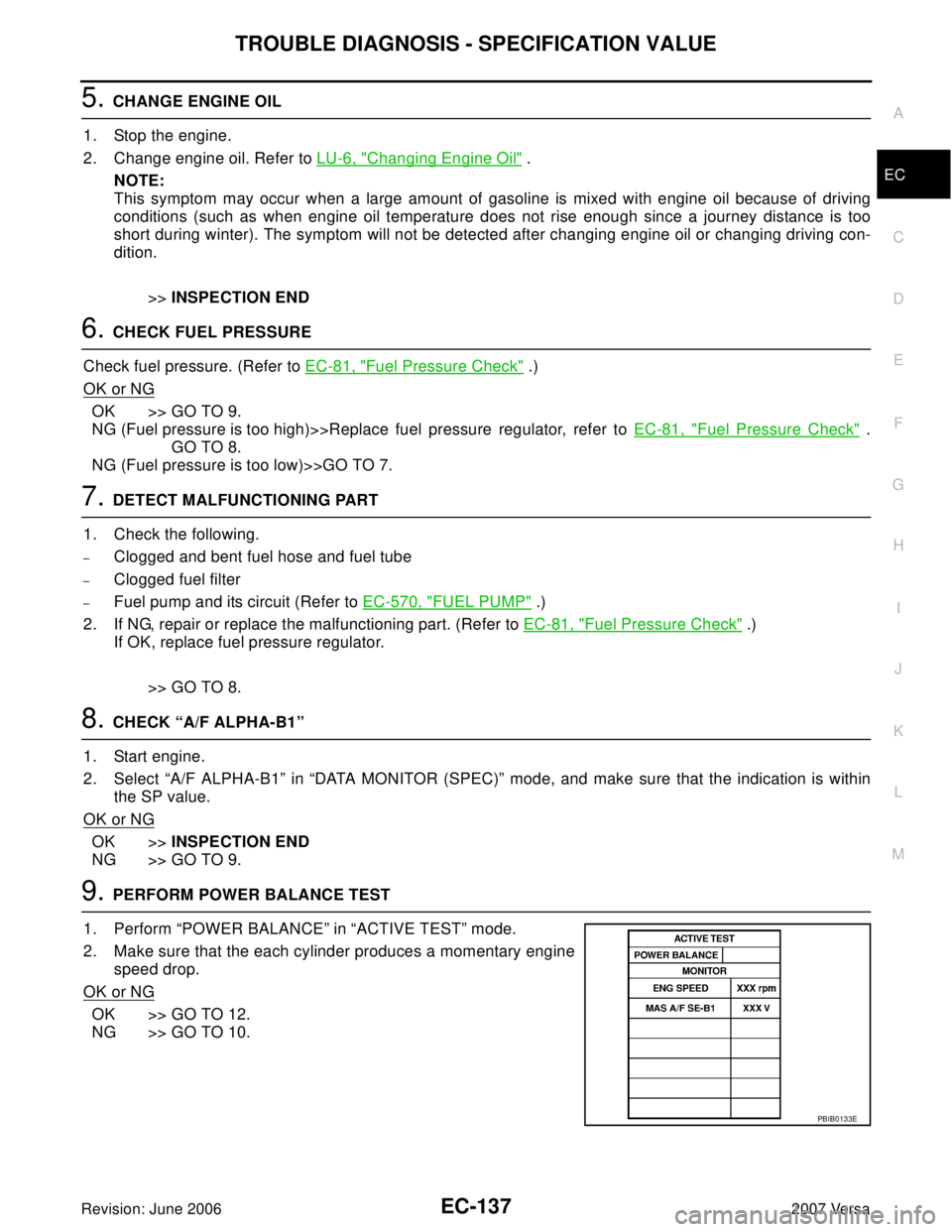
TROUBLE DIAGNOSIS - SPECIFICATION VALUE
EC-137
C
D
E
F
G
H
I
J
K
L
MA
EC
Revision: June 20062007 Versa
5. CHANGE ENGINE OIL
1. Stop the engine.
2. Change engine oil. Refer to LU-6, "
Changing Engine Oil" .
NOTE:
This symptom may occur when a large amount of gasoline is mixed with engine oil because of driving
conditions (such as when engine oil temperature does not rise enough since a journey distance is too
short during winter). The symptom will not be detected after changing engine oil or changing driving con-
dition.
>>INSPECTION END
6. CHECK FUEL PRESSURE
Check fuel pressure. (Refer to EC-81, "
Fuel Pressure Check" .)
OK or NG
OK >> GO TO 9.
NG (Fuel pressure is too high)>>Replace fuel pressure regulator, refer to EC-81, "
Fuel Pressure Check" .
GO TO 8.
NG (Fuel pressure is too low)>>GO TO 7.
7. DETECT MALFUNCTIONING PART
1. Check the following.
–Clogged and bent fuel hose and fuel tube
–Clogged fuel filter
–Fuel pump and its circuit (Refer to EC-570, "FUEL PUMP" .)
2. If NG, repair or replace the malfunctioning part. (Refer to EC-81, "
Fuel Pressure Check" .)
If OK, replace fuel pressure regulator.
>> GO TO 8.
8. CHECK “A/F ALPHA-B1”
1. Start engine.
2. Select “A/F ALPHA-B1” in “DATA MONITOR (SPEC)” mode, and make sure that the indication is within
the SP value.
OK or NG
OK >>INSPECTION END
NG >> GO TO 9.
9. PERFORM POWER BALANCE TEST
1. Perform “POWER BALANCE” in “ACTIVE TEST” mode.
2. Make sure that the each cylinder produces a momentary engine
speed drop.
OK or NG
OK >> GO TO 12.
NG >> GO TO 10.
PBIB0133E
Page 1307 of 2896
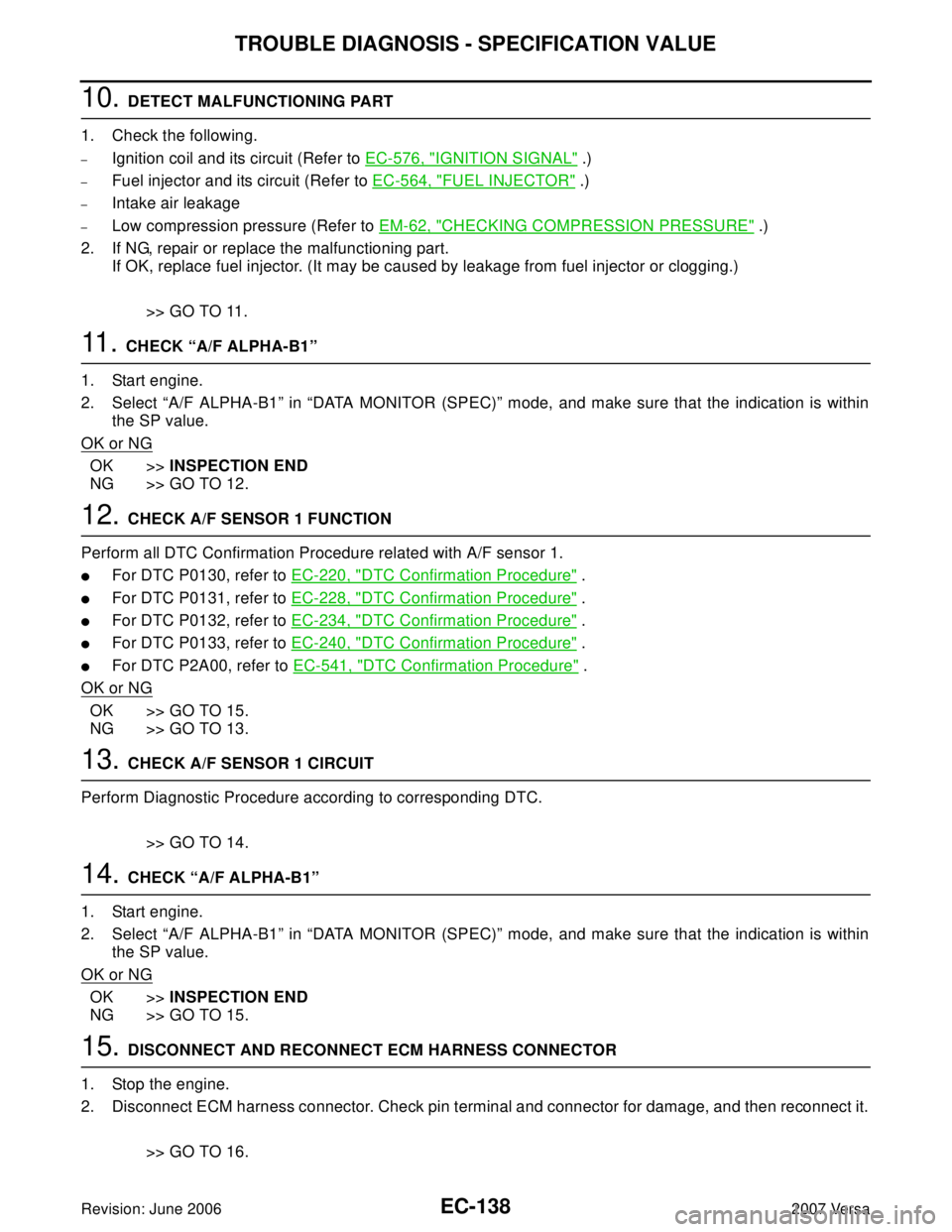
EC-138Revision: June 2006
TROUBLE DIAGNOSIS - SPECIFICATION VALUE
2007 Versa
10. DETECT MALFUNCTIONING PART
1. Check the following.
–Ignition coil and its circuit (Refer to EC-576, "IGNITION SIGNAL" .)
–Fuel injector and its circuit (Refer to EC-564, "FUEL INJECTOR" .)
–Intake air leakage
–Low compression pressure (Refer to EM-62, "CHECKING COMPRESSION PRESSURE" .)
2. If NG, repair or replace the malfunctioning part.
If OK, replace fuel injector. (It may be caused by leakage from fuel injector or clogging.)
>> GO TO 11.
11 . CHECK “A/F ALPHA-B1”
1. Start engine.
2. Select “A/F ALPHA-B1” in “DATA MONITOR (SPEC)” mode, and make sure that the indication is within
the SP value.
OK or NG
OK >>INSPECTION END
NG >> GO TO 12.
12. CHECK A/F SENSOR 1 FUNCTION
Perform all DTC Confirmation Procedure related with A/F sensor 1.
�For DTC P0130, refer to EC-220, "DTC Confirmation Procedure" .
�For DTC P0131, refer to EC-228, "DTC Confirmation Procedure" .
�For DTC P0132, refer to EC-234, "DTC Confirmation Procedure" .
�For DTC P0133, refer to EC-240, "DTC Confirmation Procedure" .
�For DTC P2A00, refer to EC-541, "DTC Confirmation Procedure" .
OK or NG
OK >> GO TO 15.
NG >> GO TO 13.
13. CHECK A/F SENSOR 1 CIRCUIT
Perform Diagnostic Procedure according to corresponding DTC.
>> GO TO 14.
14. CHECK “A/F ALPHA-B1”
1. Start engine.
2. Select “A/F ALPHA-B1” in “DATA MONITOR (SPEC)” mode, and make sure that the indication is within
the SP value.
OK or NG
OK >>INSPECTION END
NG >> GO TO 15.
15. DISCONNECT AND RECONNECT ECM HARNESS CONNECTOR
1. Stop the engine.
2. Disconnect ECM harness connector. Check pin terminal and connector for damage, and then reconnect it.
>> GO TO 16.
Page 1308 of 2896
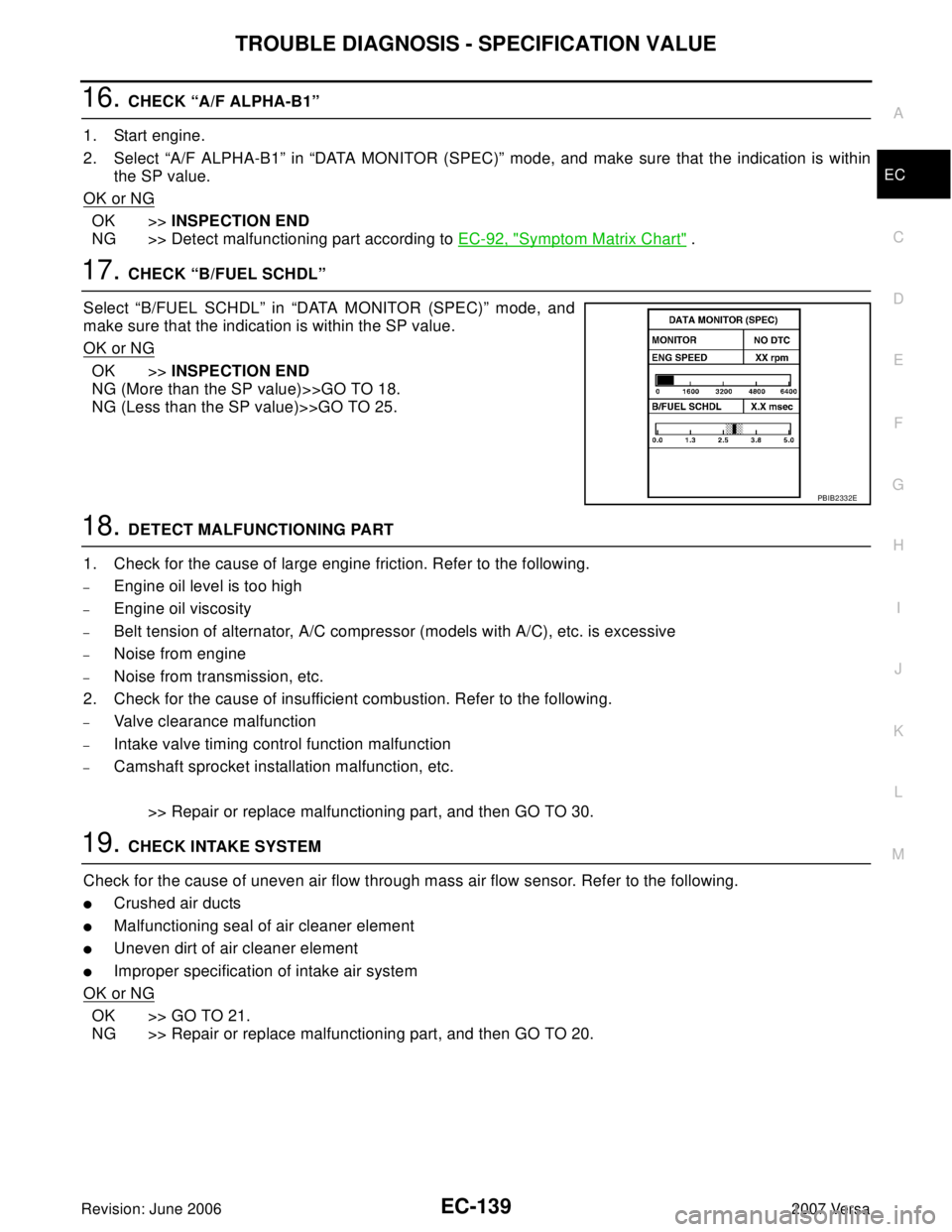
TROUBLE DIAGNOSIS - SPECIFICATION VALUE
EC-139
C
D
E
F
G
H
I
J
K
L
MA
EC
Revision: June 20062007 Versa
16. CHECK “A/F ALPHA-B1”
1. Start engine.
2. Select “A/F ALPHA-B1” in “DATA MONITOR (SPEC)” mode, and make sure that the indication is within
the SP value.
OK or NG
OK >>INSPECTION END
NG >> Detect malfunctioning part according to EC-92, "
Symptom Matrix Chart" .
17. CHECK “B/FUEL SCHDL”
Select “B/FUEL SCHDL” in “DATA MONITOR (SPEC)” mode, and
make sure that the indication is within the SP value.
OK or NG
OK >>INSPECTION END
NG (More than the SP value)>>GO TO 18.
NG (Less than the SP value)>>GO TO 25.
18. DETECT MALFUNCTIONING PART
1. Check for the cause of large engine friction. Refer to the following.
–Engine oil level is too high
–Engine oil viscosity
–Belt tension of alternator, A/C compressor (models with A/C), etc. is excessive
–Noise from engine
–Noise from transmission, etc.
2. Check for the cause of insufficient combustion. Refer to the following.
–Valve clearance malfunction
–Intake valve timing control function malfunction
–Camshaft sprocket installation malfunction, etc.
>> Repair or replace malfunctioning part, and then GO TO 30.
19. CHECK INTAKE SYSTEM
Check for the cause of uneven air flow through mass air flow sensor. Refer to the following.
�Crushed air ducts
�Malfunctioning seal of air cleaner element
�Uneven dirt of air cleaner element
�Improper specification of intake air system
OK or NG
OK >> GO TO 21.
NG >> Repair or replace malfunctioning part, and then GO TO 20.
PBIB2332E
Page 1310 of 2896
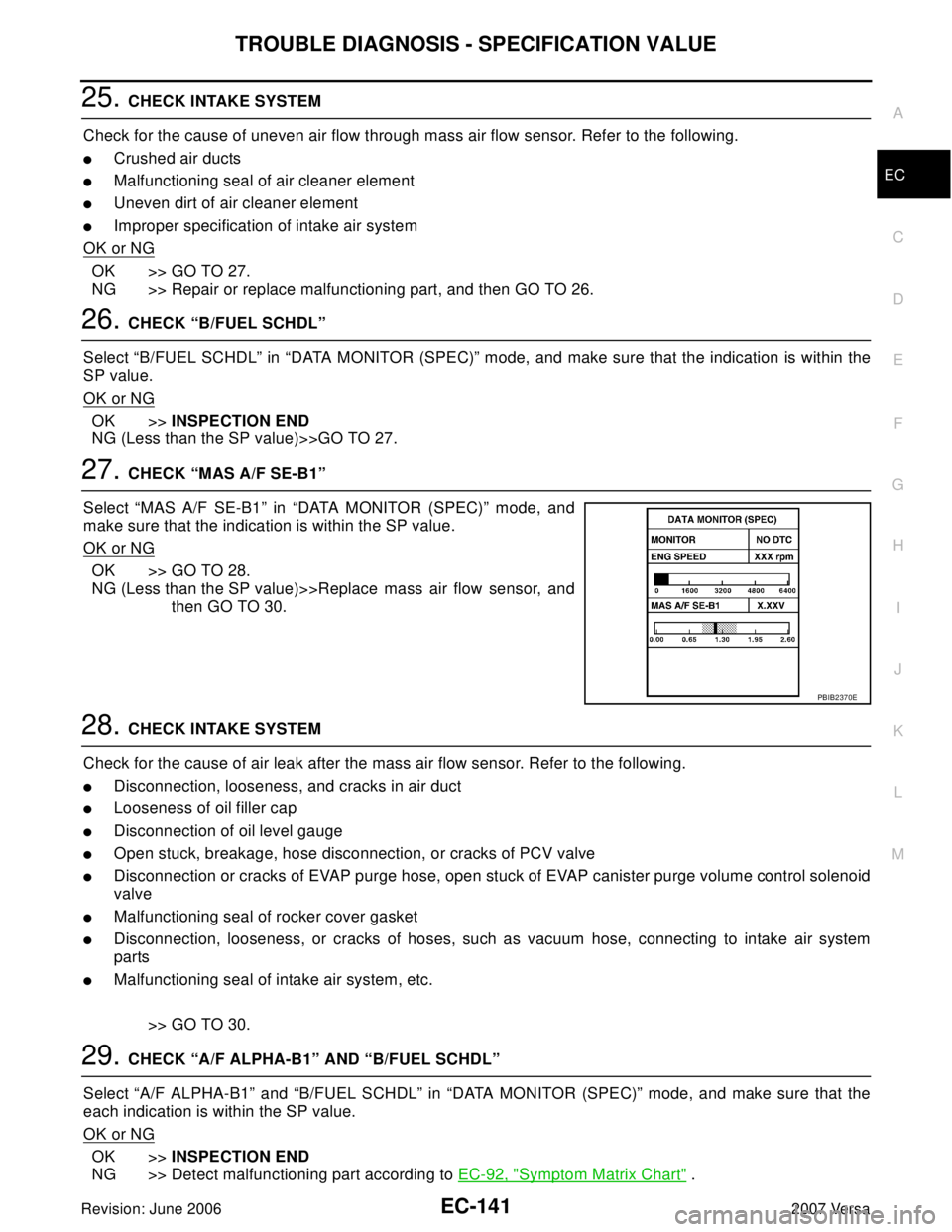
TROUBLE DIAGNOSIS - SPECIFICATION VALUE
EC-141
C
D
E
F
G
H
I
J
K
L
MA
EC
Revision: June 20062007 Versa
25. CHECK INTAKE SYSTEM
Check for the cause of uneven air flow through mass air flow sensor. Refer to the following.
�Crushed air ducts
�Malfunctioning seal of air cleaner element
�Uneven dirt of air cleaner element
�Improper specification of intake air system
OK or NG
OK >> GO TO 27.
NG >> Repair or replace malfunctioning part, and then GO TO 26.
26. CHECK “B/FUEL SCHDL”
Select “B/FUEL SCHDL” in “DATA MONITOR (SPEC)” mode, and make sure that the indication is within the
SP value.
OK or NG
OK >>INSPECTION END
NG (Less than the SP value)>>GO TO 27.
27. CHECK “MAS A/F SE-B1”
Select “MAS A/F SE-B1” in “DATA MONITOR (SPEC)” mode, and
make sure that the indication is within the SP value.
OK or NG
OK >> GO TO 28.
NG (Less than the SP value)>>Replace mass air flow sensor, and
then GO TO 30.
28. CHECK INTAKE SYSTEM
Check for the cause of air leak after the mass air flow sensor. Refer to the following.
�Disconnection, looseness, and cracks in air duct
�Looseness of oil filler cap
�Disconnection of oil level gauge
�Open stuck, breakage, hose disconnection, or cracks of PCV valve
�Disconnection or cracks of EVAP purge hose, open stuck of EVAP canister purge volume control solenoid
valve
�Malfunctioning seal of rocker cover gasket
�Disconnection, looseness, or cracks of hoses, such as vacuum hose, connecting to intake air system
parts
�Malfunctioning seal of intake air system, etc.
>> GO TO 30.
29. CHECK “A/F ALPHA-B1” AND “B/FUEL SCHDL”
Select “A/F ALPHA-B1” and “B/FUEL SCHDL” in “DATA MONITOR (SPEC)” mode, and make sure that the
each indication is within the SP value.
OK or NG
OK >>INSPECTION END
NG >> Detect malfunctioning part according to EC-92, "
Symptom Matrix Chart" .
PBIB2370E
Page 1327 of 2896
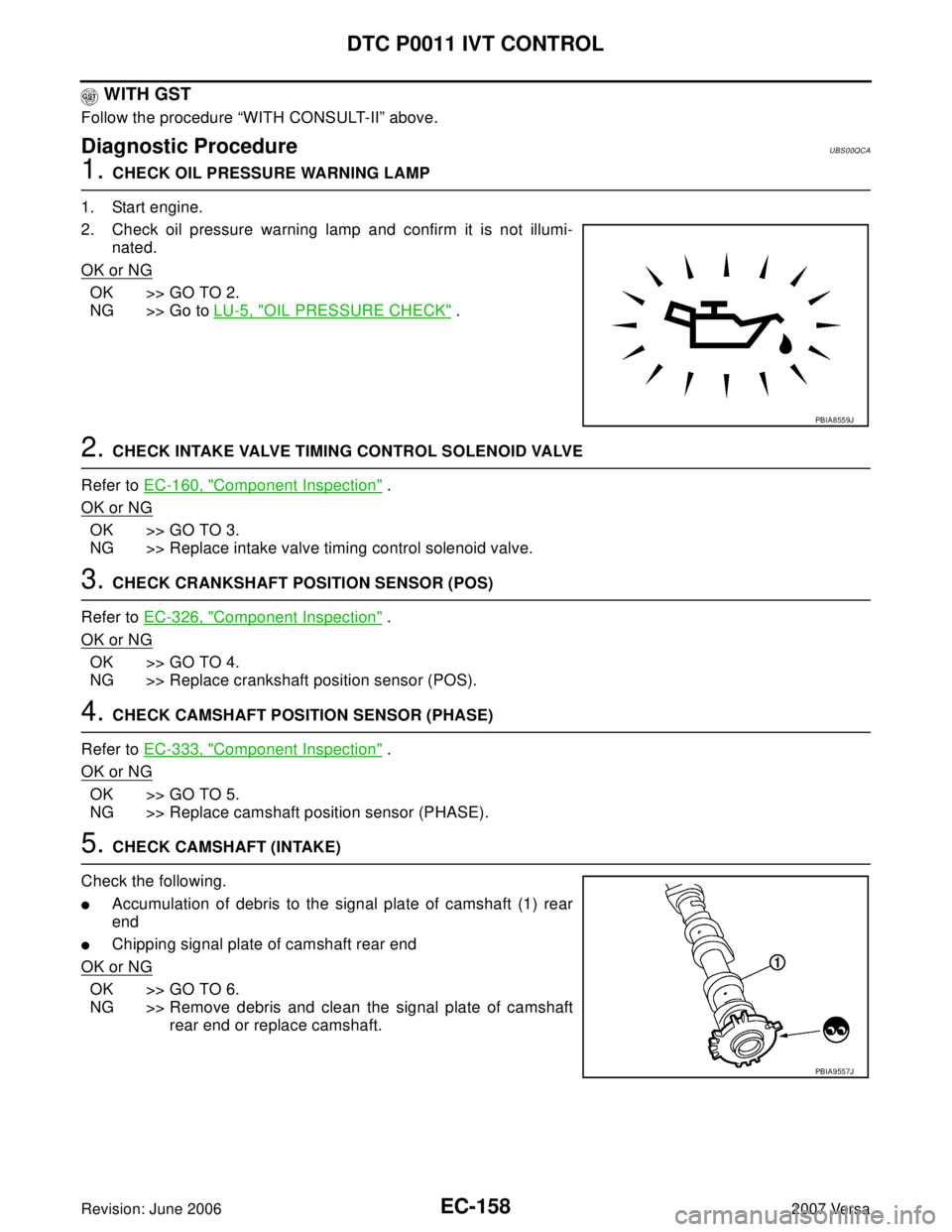
EC-158Revision: June 2006
DTC P0011 IVT CONTROL
2007 Versa
WITH GST
Follow the procedure “WITH CONSULT-II” above.
Diagnostic ProcedureUBS00QCA
1. CHECK OIL PRESSURE WARNING LAMP
1. Start engine.
2. Check oil pressure warning lamp and confirm it is not illumi-
nated.
OK or NG
OK >> GO TO 2.
NG >> Go to LU-5, "
OIL PRESSURE CHECK" .
2. CHECK INTAKE VALVE TIMING CONTROL SOLENOID VALVE
Refer to EC-160, "
Component Inspection" .
OK or NG
OK >> GO TO 3.
NG >> Replace intake valve timing control solenoid valve.
3. CHECK CRANKSHAFT POSITION SENSOR (POS)
Refer to EC-326, "
Component Inspection" .
OK or NG
OK >> GO TO 4.
NG >> Replace crankshaft position sensor (POS).
4. CHECK CAMSHAFT POSITION SENSOR (PHASE)
Refer to EC-333, "
Component Inspection" .
OK or NG
OK >> GO TO 5.
NG >> Replace camshaft position sensor (PHASE).
5. CHECK CAMSHAFT (INTAKE)
Check the following.
�Accumulation of debris to the signal plate of camshaft (1) rear
end
�Chipping signal plate of camshaft rear end
OK or NG
OK >> GO TO 6.
NG >> Remove debris and clean the signal plate of camshaft
rear end or replace camshaft.
PBIA8559J
PBIA9557J
Page 1329 of 2896
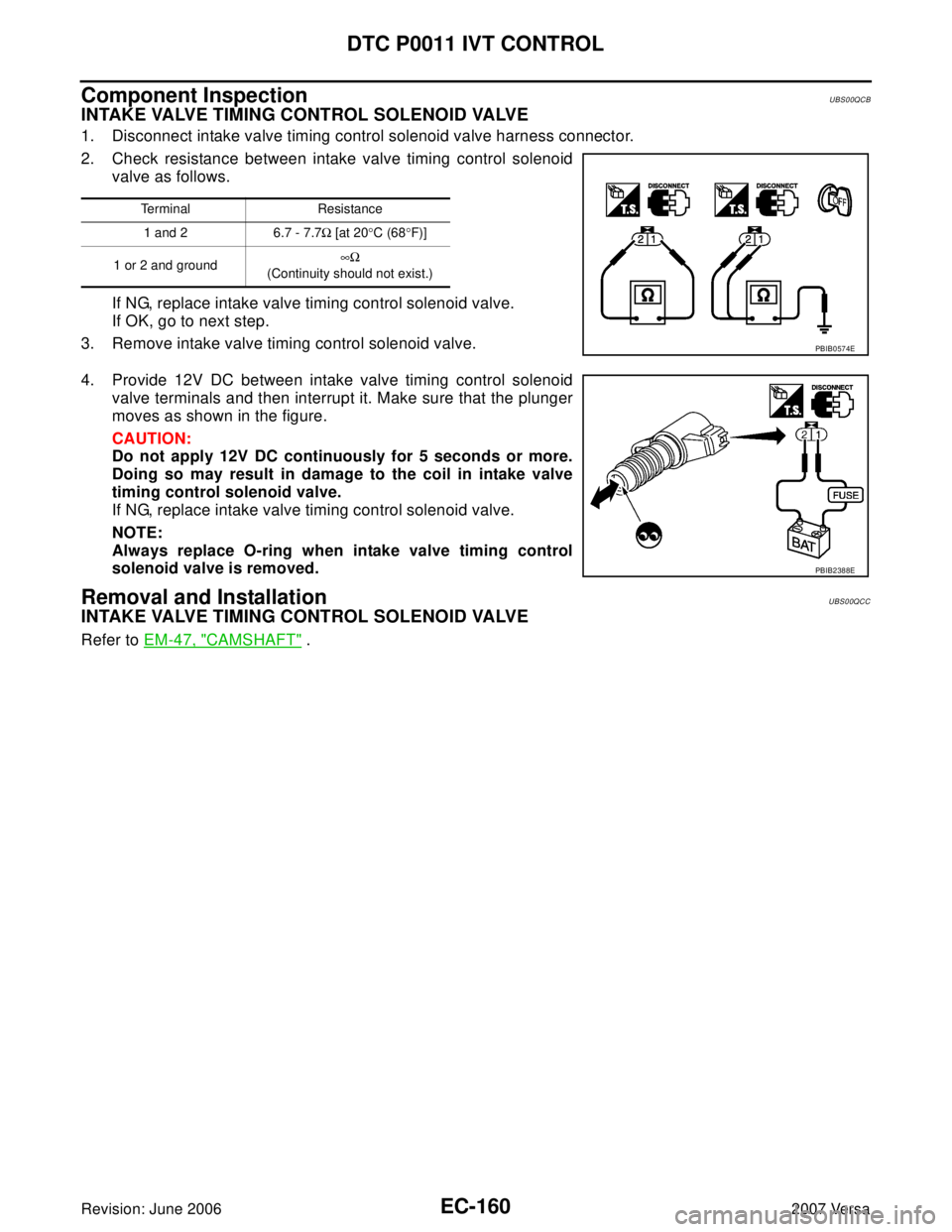
EC-160Revision: June 2006
DTC P0011 IVT CONTROL
2007 Versa
Component InspectionUBS00QCB
INTAKE VALVE TIMING CONTROL SOLENOID VALVE
1. Disconnect intake valve timing control solenoid valve harness connector.
2. Check resistance between intake valve timing control solenoid
valve as follows.
If NG, replace intake valve timing control solenoid valve.
If OK, go to next step.
3. Remove intake valve timing control solenoid valve.
4. Provide 12V DC between intake valve timing control solenoid
valve terminals and then interrupt it. Make sure that the plunger
moves as shown in the figure.
CAUTION:
Do not apply 12V DC continuously for 5 seconds or more.
Doing so may result in damage to the coil in intake valve
timing control solenoid valve.
If NG, replace intake valve timing control solenoid valve.
NOTE:
Always replace O-ring when intake valve timing control
solenoid valve is removed.
Removal and InstallationUBS00QCC
INTAKE VALVE TIMING CONTROL SOLENOID VALVE
Refer to EM-47, "CAMSHAFT" .
Terminal Resistance
1 and 2 6.7 - 7.7Ω [at 20°C (68°F)]
1 or 2 and ground∞Ω
(Continuity should not exist.)
PBIB0574E
PBIB2388E
Page 1346 of 2896
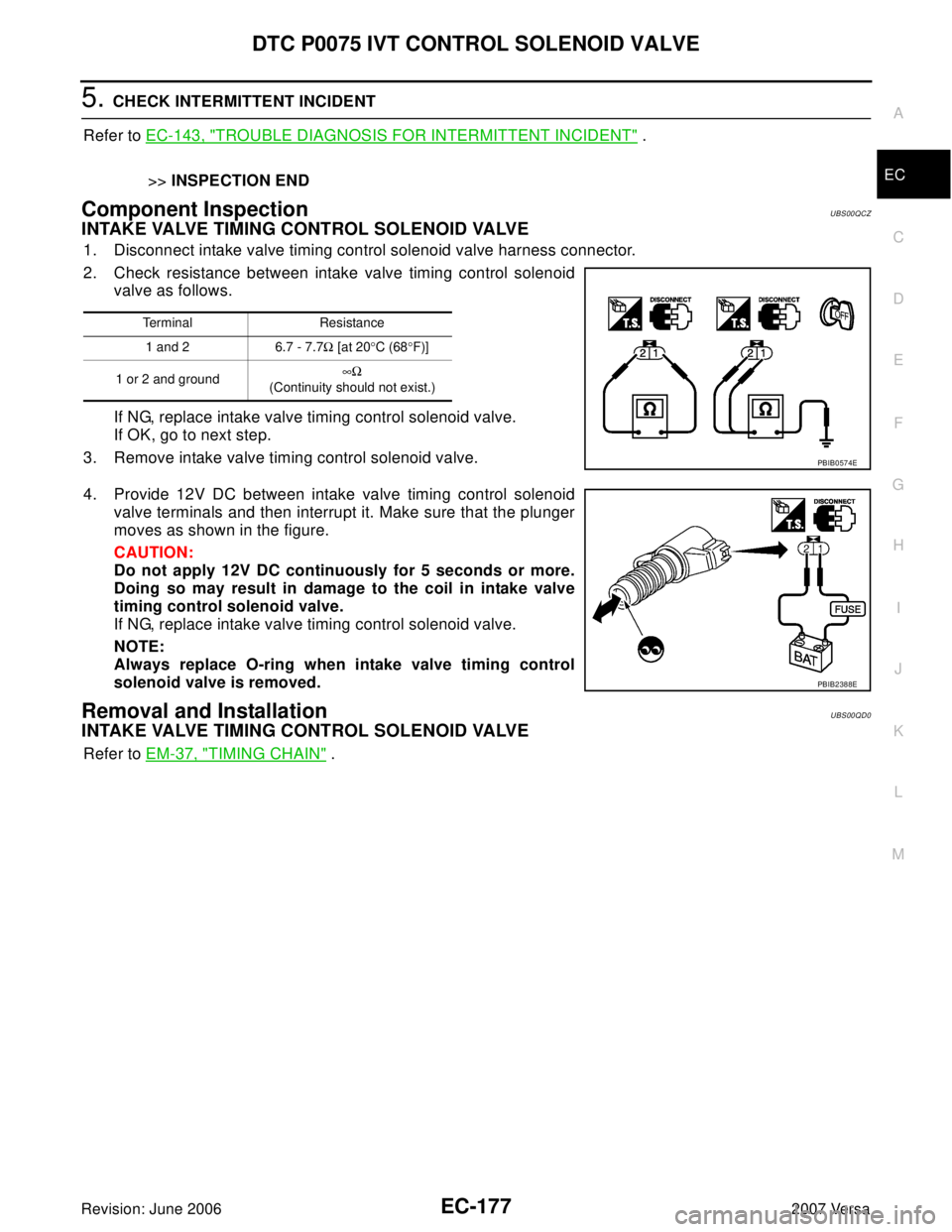
DTC P0075 IVT CONTROL SOLENOID VALVE
EC-177
C
D
E
F
G
H
I
J
K
L
MA
EC
Revision: June 20062007 Versa
5. CHECK INTERMITTENT INCIDENT
Refer to EC-143, "
TROUBLE DIAGNOSIS FOR INTERMITTENT INCIDENT" .
>>INSPECTION END
Component InspectionUBS00QCZ
INTAKE VALVE TIMING CONTROL SOLENOID VALVE
1. Disconnect intake valve timing control solenoid valve harness connector.
2. Check resistance between intake valve timing control solenoid
valve as follows.
If NG, replace intake valve timing control solenoid valve.
If OK, go to next step.
3. Remove intake valve timing control solenoid valve.
4. Provide 12V DC between intake valve timing control solenoid
valve terminals and then interrupt it. Make sure that the plunger
moves as shown in the figure.
CAUTION:
Do not apply 12V DC continuously for 5 seconds or more.
Doing so may result in damage to the coil in intake valve
timing control solenoid valve.
If NG, replace intake valve timing control solenoid valve.
NOTE:
Always replace O-ring when intake valve timing control
solenoid valve is removed.
Removal and InstallationUBS00QD0
INTAKE VALVE TIMING CONTROL SOLENOID VALVE
Refer to EM-37, "TIMING CHAIN" .
Terminal Resistance
1 and 2 6.7 - 7.7Ω [at 20°C (68°F)]
1 or 2 and ground∞Ω
(Continuity should not exist.)
PBIB0574E
PBIB2388E
Page 1451 of 2896
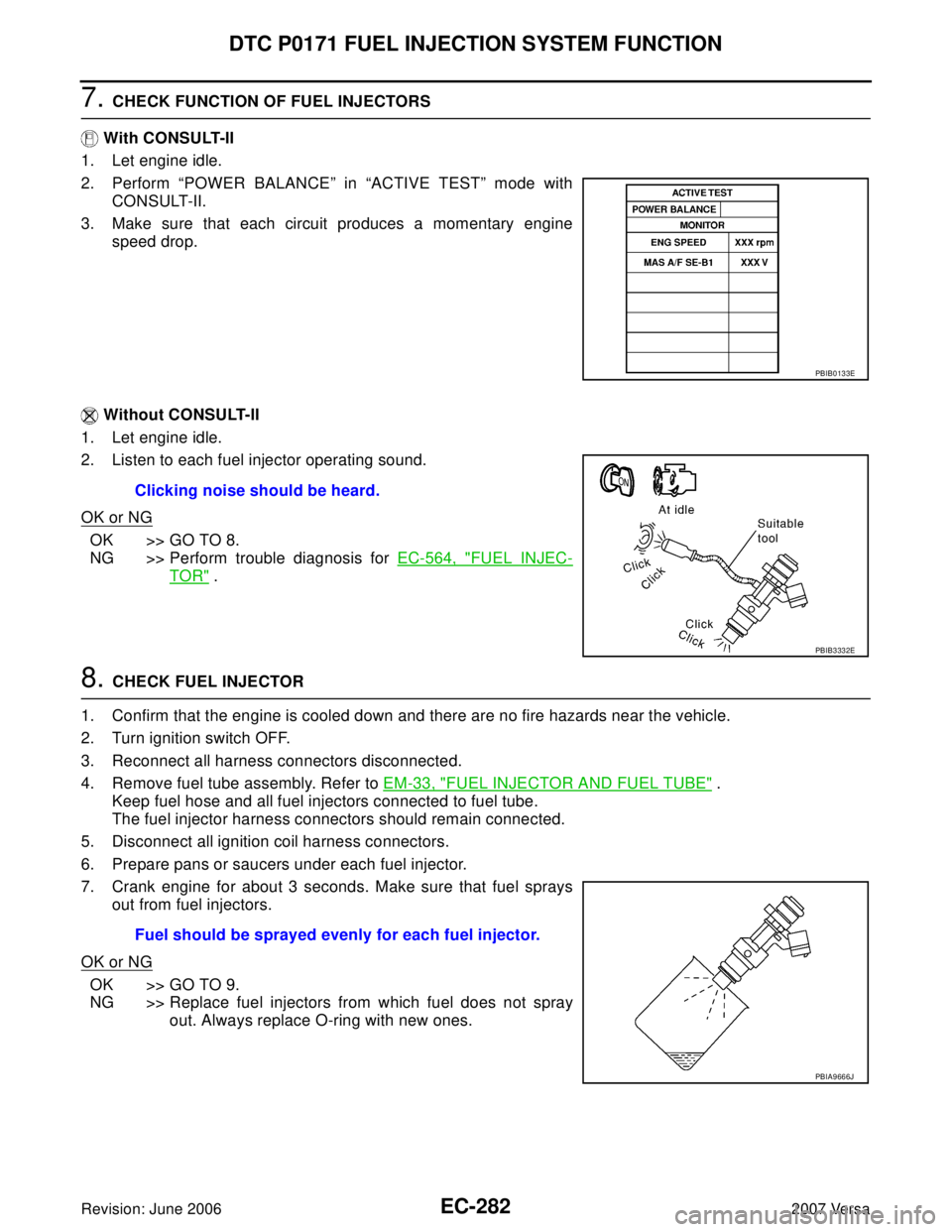
EC-282Revision: June 2006
DTC P0171 FUEL INJECTION SYSTEM FUNCTION
2007 Versa
7. CHECK FUNCTION OF FUEL INJECTORS
With CONSULT-II
1. Let engine idle.
2. Perform “POWER BALANCE” in “ACTIVE TEST” mode with
CONSULT-II.
3. Make sure that each circuit produces a momentary engine
speed drop.
Without CONSULT-II
1. Let engine idle.
2. Listen to each fuel injector operating sound.
OK or NG
OK >> GO TO 8.
NG >> Perform trouble diagnosis for EC-564, "
FUEL INJEC-
TOR" .
8. CHECK FUEL INJECTOR
1. Confirm that the engine is cooled down and there are no fire hazards near the vehicle.
2. Turn ignition switch OFF.
3. Reconnect all harness connectors disconnected.
4. Remove fuel tube assembly. Refer to EM-33, "
FUEL INJECTOR AND FUEL TUBE" .
Keep fuel hose and all fuel injectors connected to fuel tube.
The fuel injector harness connectors should remain connected.
5. Disconnect all ignition coil harness connectors.
6. Prepare pans or saucers under each fuel injector.
7. Crank engine for about 3 seconds. Make sure that fuel sprays
out from fuel injectors.
OK or NG
OK >> GO TO 9.
NG >> Replace fuel injectors from which fuel does not spray
out. Always replace O-ring with new ones.
PBIB0133E
Clicking noise should be heard.
PBIB3332E
Fuel should be sprayed evenly for each fuel injector.
PBIA9666J